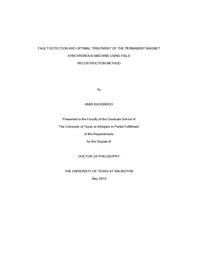
ATTENTION: The works hosted here are being migrated to a new repository that will consolidate resources, improve discoverability, and better show UTA's research impact on the global community. We will update authors as the migration progresses. Please see MavMatrix for more information.
Show simple item record
| dc.contributor.author | Khoobroo, Amir | en_US |
| dc.date.accessioned | 2010-11-01T21:28:47Z | |
| dc.date.available | 2010-11-01T21:28:47Z | |
| dc.date.issued | 2010-11-01 | |
| dc.date.submitted | January 2010 | en_US |
| dc.identifier.other | DISS-10723 | en_US |
| dc.identifier.uri | http://hdl.handle.net/10106/5115 | |
| dc.description.abstract | Permanent magnet synchronous machines (PMSM) are used extensively in industrial applications due to their relatively high power density, high efficiency, negligible rotor losses, maintenance free operation, and ease of control. Fault tolerance has become a design criterion for adjustable speed motor drives (ASMD) which are used in high impact applications. In simple terms, a fault tolerant ASMD is expected to continue its intended function in the event of a failure compliment to its remaining components. A wide variety of the research has been done on the techniques of fault detection. Most of these researches focus solely on the fault detection and less attention is paid to treatment of the faults. This dissertation investigates fault detection and clearance in a PMSM using the field reconstruction method. Also, the optimal excitation of the machine for optimal performance under healthy and faulty modes of operation has been investigated. Initially an accurate Finite Element (FE) model is developed for the PMSM using the MAGNET software (©infolytica) as a reference for comparison. This model is used to analyze the electromagnetic behavior of the PMSM during normal and faulty operating conditions. As the FE analysis is time consuming, Field Reconstruction Method (FRM) is developed and implemented to minimize the computational time while maintaining an acceptable accuracy. The FRM provides a precise distribution of the magnetic field components for PMSM. A new flux estimation technique is developed to monitor magnetic flux passing through each stator tooth. Also, the flux linking each stator phase can be determined using the flux estimator.In order to detect the faults specific signatures have been identified and detected. For the faults under study, (i.e. stator inter-turn short circuit, rotor partial demagnetization and rotor static eccentricity) there are measurable signatures in the magnetic flux that are used for detection purposes. Finally, based on the type and location of the fault a optimal stator currents are calculated. Once a fault is detected, the faulty component would be disengaged if possible. Then, the optimal currents would be applied to the remaining stator phases to guarantee the appropriate operation of the machine. The above mentioned steps have been supported by simulation and experimental results. | en_US |
| dc.description.sponsorship | Fahimi, Babak | en_US |
| dc.language.iso | en | en_US |
| dc.publisher | Electrical Engineering | en_US |
| dc.title | Fault Detection And Optimal Treatment Of The Permanent Magnet Synchronous Machine Using Field Reconstruction Method | en_US |
| dc.type | Ph.D. | en_US |
| dc.contributor.committeeChair | Fahimi, Babak | en_US |
| dc.degree.department | Electrical Engineering | en_US |
| dc.degree.discipline | Electrical Engineering | en_US |
| dc.degree.grantor | University of Texas at Arlington | en_US |
| dc.degree.level | doctoral | en_US |
| dc.degree.name | Ph.D. | en_US |
Files in this item
- Name:
- Khoobroo_uta_2502D_10723.pdf
- Size:
- 6.110Mb
- Format:
- PDF
This item appears in the following Collection(s)
Show simple item record


